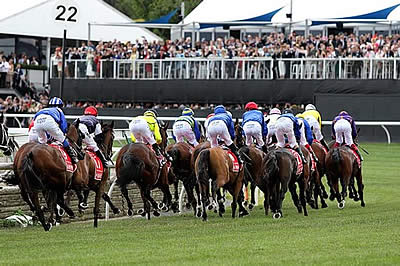The 2019 VRC Melbourne Cup is a Group I handicap race and it is Australia’s most famous annual Thoroughbred horse race. It is a 1.988 mile race for three-year-olds and over, conducted by the Victoria Racing Club on the Flemington Racecourse in Melbourne, Victoria as part of the Melbourne Spring Racing Carnival. It is the richest “two-mile” handicap in the world, and one of the richest turf races. The event starts at 3pm on the first Tuesday in November and is known locally as “the race that stops a nation”.
The Melbourne Cup field typically comprises a star-studded array of both local and international horse racing champions. The horses that compete in the Melbourne Cup are chosen according to a range of parameters. Inferior racehorses are balloted out based on a range of metrics, such as handicap weight and performance in certain races. If you love horse racing betting, claim the TVG promo code! You can get money back when you place your first bet.
Balloting conditions are that the race directors retain the absolute discretion to exclude any horse from the race, or exempt any horse from the ballot on the race, but in order to reduce the field to the safety limit of 24, horses are balloted out based on a number of factors which include
1000 in prize money earned in the previous two years, 9 wins or placings in certain lead-up races and 3 allocated handicap weight.
Betting on the Melbourne Cup is one of the most Australian things you can do and millions of people have a flutter every year in an attempt to snare the win. The ultimate test of stamina and staying power, the Melbourne Cup is raced over a punishing distance of 3,200 metres (1.988 miles). More grueling than any other major event in Melbourne’s Spring Racing Carnival, the prestigious race places extraordinary demands on the contestants, and bestows exceptional glory upon the winners.
In addition to the huge Australian audience that drops everything each November to follow the race, the Melbourne Cup has also captured the imaginations of countless international racing fans.
With close to half of the field for the 2017 Melbourne Cup being raiders trained outside of Australia and New Zealand, the event has blossomed into a truly global affair. Australia does not have a reputation for breeding genuine stayers so, each year, the Melbourne Cup field features more and more internationally bred and trained horses. In recent years, international horses have dominated Melbourne Cup races.
The total prize money for the 2019 race is $8,000,000, plus trophies valued at $250,000. The first 12 past the post receive prize money, with the winner Cross Counter being paid $4 million, second $1 million, third $500,000, fourth $250,000, fifth $175,000, with sixth through twelfth place earning $150,000.
Prize money is distributed to the connections of each horse in the ratio of 85 percent to the owner, 10 percent to the trainer, and 5 percent to the jockey.
For thoroughbred racehorses, the prestigious Melbourne Cup is the world’s richest handicap. The competitive landscape has changed considerably in Australia in recent times, leaving the Melbourne Cup as one of few authentic, two-mile horse races. The Andrew Ramsden Stakes at Flemington Racecourse and the Sydney Cup in NSW are the only other 3,200 metre Group 1 races on Australian shores.
The Melbourne Cup has a long tradition, with the first race held in 1861. It was originally over two miles (3.219 km) but was shortened to 3,200 metres (1.988 mi) in 1972 when Australia adopted the metric system. This reduced the distance by 18.688 metres (61.312 ft), and Rain Lover’s 1968 race record of 3:19.1 was accordingly adjusted to 3:17.9. The present record holder is the 1990 winner Kingston Rule with a time of 3:16.3.
Lasting for approximately three and a half minutes, the Melbourne Cup is the ultimate test of strength, speed, and endurance. A Bart Cummings-trained horse Kingston Rule famously obliterated the competition back in 1990 to set an all-time record of 3:16.30 minutes.
